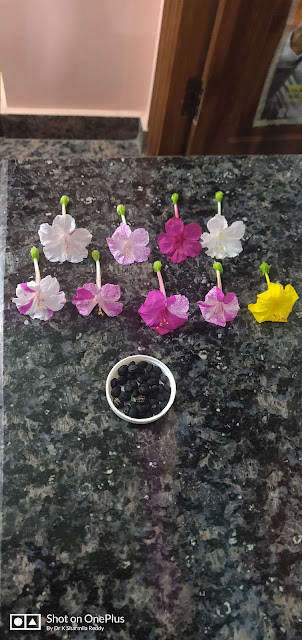Scientific Name- Mirabilis jalapa
IUCN Status- Not Evaluated
|
It is the Children’s State Flower
of Connecticut (an US State) under
the name of Michaela Petit’s Four 0’
clocks. (Michaela was among the 3 died in Cheshire Home invasion murders
in 2007. 4 ‘0’ Clocks are her favorite.)
Its Generic name Mirabilis is derived from a Latin word which
means Wonderful- to be admired.
Its Species name has 2 attributes. Some say it is from Jalapa- a city of Mexico. Some say it is originally Xalapa- a city of Guatemala. Both these seem to be true- as Mirabilis is native of Central and South America- Guatemala, Mexico, Chile and Peru.
It is now a naturalized exotic worldwide.
Its Species name has 2 attributes. Some say it is from Jalapa- a city of Mexico. Some say it is originally Xalapa- a city of Guatemala. Both these seem to be true- as Mirabilis is native of Central and South America- Guatemala, Mexico, Chile and Peru.
It is now a naturalized exotic worldwide.
The flowers of Mirabilis open in the late afternoon and close to
next morning. Hence they are named 4’0’
Clocks.
In Maldives, it is called Asurumaa. ‘Asr’ means obligatory prayer
of Muslims performed between 3-4PM in Maldives. Thus supporting the claim of 4 ‘0’
Clock flower.
It is a bushy, perennial herbaceous
plant with long ovate lanceolate smooth leaves and heavy tuberous roots.
Flowers are fragrant, funnel shaped and
penta-lobed with stamens protuding from center as a cluster.
Colors are variable- white, pink, red and yellow- either plain or stripped or mottled with other shades.
Colors are variable- white, pink, red and yellow- either plain or stripped or mottled with other shades.
It propagates by seeds.
Seed is spherical, wrinkled started out as greenish yellow, eventually turn black on maturity.
Seed is spherical, wrinkled started out as greenish yellow, eventually turn black on maturity.
Another unique feature of Mirabilis
is its color changing phenomenon. A
plant on maturity changes the color of its flowers. Initially yellow can become
pink on maturity or vice versa.
Mirabilis has multiple uses. Its
flowers are used in food coloring and for dying textiles.
In Peru, juice from flowers is used to cure Herpes Lesions and Earaches.
Its leaves are eaten as a vegetable. Its bulbous roots have a laxative effect.
In Peru, juice from flowers is used to cure Herpes Lesions and Earaches.
Its leaves are eaten as a vegetable. Its bulbous roots have a laxative effect.





















Very good information
ReplyDeleteBeautiful information I got...abt Chandrakant....
ReplyDeleteGood work. Varients are really very eye catching
ReplyDelete